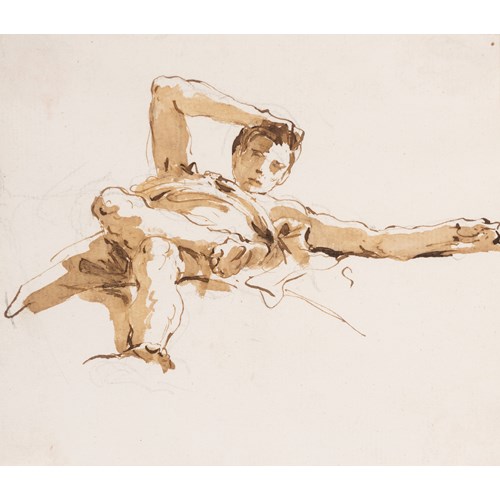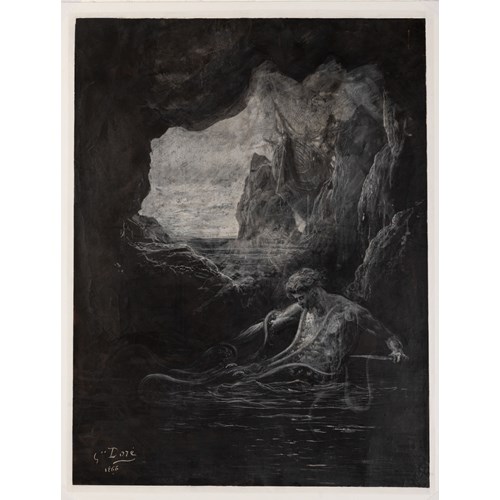John Robert COZENS
A View near Sallanches, Savoy
Date 1778
Epoque 18th century
Origine Savoy
Medium Watercolour and pencil on paper, laid down on the artist’s original mount.
Dimension 36.9 x 53.9 cm (14¹/₂ x 21¹/₄ inches)
Only a year older than Cozens, Richard Payne Knight (1751-1824) had made his first Grand Tour in 1772-1773, and was a noted connoisseur of art. His taste and interest in landscape painting tended towards the picturesque, and in particular the ‘sublime’ in nature, and Cozens’s depictions of the grandeur and majesty of the Alps would no doubt have greatly appealed to him. As Kim Sloan has written of the artist’s Swiss watercolours, ‘his views are characterized by their effect on emotions, senses, or passions…as well as on memory in the form of historical or literary associations…They are the first visual interpretation of the Alps to display these characteristics which were already well-established in Engihs poetry and prose…John Robert Cozens had finally lifted watercolour painting out of the topographical recording of nature, to a new level where it was capable of fulfilling the serious intentions of art as oil painting.’
Worked up from the smaller, monochromatic Payne Knight drawing in the Whitworth Art Gallery, this large watercolour was drawn in 1778, during Cozens’s first stay in Rome. While the composition of both drawings is identical, the artist has added the shepherd and his flock at the lower left of the present sheet, while at the same time stripping the trees at the right of the foliage that appears in the earlier preparatory sketch. The mountain in the distance is likely to be the peak known as Tête de Colonney, above Sallanches to the northeast. Other views of the same area by Cozens include Bank of the Arve near Sallanches in Savoy and Between Sallanches and Servoz, Mont Blanc in the Distance, both recorded in pen and wash drawings in the collection of the British Museum.
Drawn in subtle washes of pale blue, green and gray, View near Sallanches is part of a group of large-scale finished watercolours of Swiss views produced in Rome by Cozens between 1777 and 1779. Comparable examples include Between Chamonix and Martigny and Ober Hasli Valley from the South East, both in the Victoria and Albert Museum in London6, as well as other watercolours in the Birmingham Museum & Art Gallery, the National Gallery of Ireland in Dublin, the Yale Center for British Art in New Haven and a number of private collections. As Paul Oppé has aptly written of these early watercolours, ‘when in 1778 Cozens was signing and dating a number of large water-colours either from the Alpine sketches or from drawings made in Rome and the neighbourhood, he was already exhibiting, almost in its perfection, the refined scheme of colour and the consummate technical skill which were recognized from the first, and are still felt to be, the characteristic note of his art. Apart from any reference to nature, the harmonies and subtleties of his blues and greens are an immediate and permanent joy to the eye, and, without attempting to reproduce in full the manifold varieties of the natural scene, they provide an admirable medium for representing certain atmospheric effects of light, mist and distance…In the finished water-colours of the Alpine series something of the cool freshness of the Payne Knight drawings has been lost and the scene changed from an apparently literal transcript to a vision, almost a dream. The tonality in light blue-greens is exquisitely modulated to suggest the forms of mountain-sides, the texture of their surfaces, and the clear or misty character of the intervening atmosphere. The unity of tone produces the pervading harmony of a reflection in water.’
A later watercolour version of this composition, of similar dimensions and dated 1779, was sold as part of the collection of Norman D. Newall at auction in London in 1979. A smaller and previously unrecorded watercolour variant of this view appeared at auction in London in 1989.
The present sheet was once in the collection of the art historian A. J. Finberg (1866-1939), who was best known for his scholarship on J. M. W. Turner.
Date: 1778
Epoque: 18th century
Origine: Savoy
Medium: Watercolour and pencil on paper, laid down on the artist’s original mount.
Signature: Signed and dated John Cozens 1778 at the lower left of the mount and inscribed nr. Salanches in Savoy at the lower right of the original mount.
Inscribed Near Salanche in Savoy on the verso.
Further inscribed This drawing lent to GH by Dr. Richardson / of the Times paper(?) on the verso.
Dimension: 36.9 x 53.9 cm (14¹/₂ x 21¹/₄ inches)
Provenance: Possibly Richard Payne Knight, London
Alexander Joseph Finberg, London
His sale, London, Christie’s, 8 July 1921, lot 19 (sold for £152.5s. to Pawsey & Payne)
Pawsey & Payne, London
Anonymous sale, London, Christie’s, 20 July 1928, lot 152 (sold for £131.5s. to Palser)
J. Palser and Sons, London
M. G. M. Bevan, in 1951
Private collection
Thence by descent until Anonymous sale, London, Sotheby’s, 14 July 1994, lot 112
Anonymous sale, London, Christie’s, 5 July 2016, lot 95.
Literature: C. F. Bell and Thomas Girtin, ‘The Drawings and Sketches of John Robert Cozens’, The Walpole Society, Vol.23, 1934-1935, p.28, no.6 [II] (not illustrated); London, Sotheby’s, Eighteenth and Nineteenth Century British Drawings and Watercolours, 13 July 1989, p.82, under lot 114; Emma Crichton-Miller, ‘Collectors’ Focus: British watercolours’, Apollo, March 2020, p.169, fig.2.
Exhibition: London, Leggatt Brothers, Exhibition of English Painters 1700-1850, 1951, no.37 (lent by M. G. M. Bevan).
Plus d'œuvres d'art de la Galerie





 in a Glass ‘Liebe Tante, ich bin im Moment etwas nervös…’_T638203653974598426.jpg?width=500&height=500&mode=pad&scale=both&qlt=90&format=jpg)



